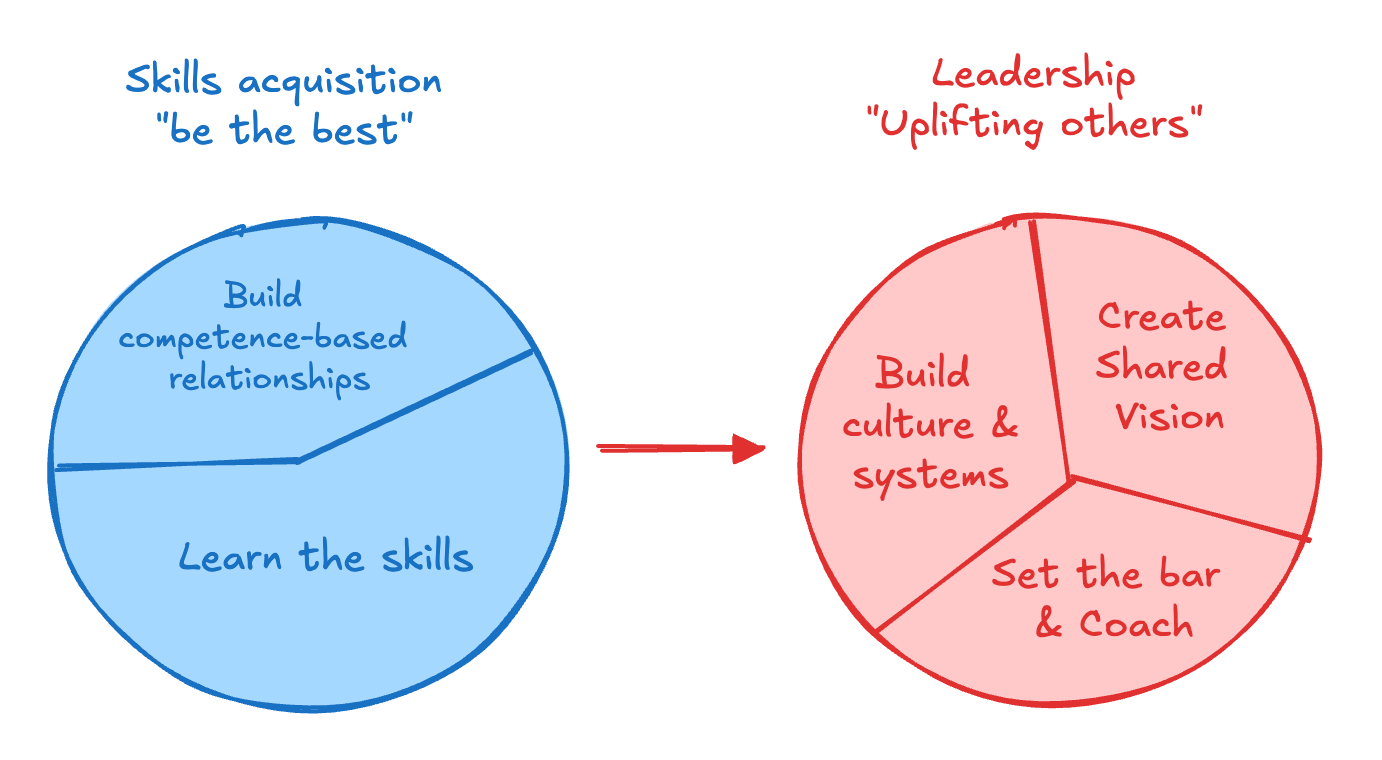How to Lead Through Systems, Not Skills
Being "the best" got us into leadership. Learning how to build effective systems and retain great people propels you into the executive levels.
I used to believe that being a leader meant that I had to be the best product manager. I needed to have all the right answers. I needed to have all the context and information. I needed to do any product task better and faster than those on my team. After all, if I didn’t have those things, then what value am I adding to my team? How is it that I “deserve” to be the leader?
In the early phases of our careers, getting ahead means mastering skills to do the role. Learn the job, do the tasks, and get recognition as a high performer. We get recognized for being the best at a task. As we move up the ranks, being an expert at a task holds decreasing importance. Leadership is a deeply human role that involves building trust, creating systems, and bringing large groups of people together behind a shared vision.
The Downsides of Leading Through Output
Many high performers adopt a form of “let me tell you” when first approaching leadership. It’s a natural progression from “I’m doing it all” to “Let me show you how to do it so you can help me do more.” With this approach, leaders essentially try to create a version of themselves in their teams.
Leading through telling people what to do, because you do it best, works when the task has predictable inputs and outputs and is repetitive. Assembly lines, many low-skill jobs, and companies in industries where they’re mostly repeating what competition has already invented, tend towards this leadership style.
This top-down, control-focused leadership style has one huge downside: a lack of localized decision-making at scale. Scaling localized decision-making is the secret sauce for innovation, speed, and retaining high performers. In today’s changing business environment, speed and innovation are critical competitive advantages for any team.
When people feel controlled by others, restlessness grows. Some people become demotivated, and others become resentful. External motivators like money and titles can mask the problem for some time, but the discontent remains.
In addition, when people are not encouraged to voice a different perspective, the same problems and solutions get rehashed. As a whole, when there is a lack of localized autonomy, the organization is slow to learn and fails to generate impactful new ideas.
Finally, leaders often also grow tired of having to have all the answers and keep everything on track. Because of the need to control and make top-down decisions, they also cannot discuss their problems with others. Many feel increasingly alone and unsupported as a result.
Yue’s Coaching Corner
Join me for a free talk on “AI-powered Stakeholder Management” on October 28. Sign up to attend live or get the recording emailed.
Calling my Europe & Asia readers! In January, I’ll be running a group coaching cohort that is Asia/Europe time zone friendly. If you’ve been wanting to uplevel your leadership skillset, join the Leadership Accelerator program for mid-career professionals. Learn more here.
Interested in 1:1 executive coaching to close the year strong? Hop on a free intro call and see if working with me is a fit.
Scaling Impact Through Systems
Great leaders focus on creating a system where information and context travel at high bandwidth. Rather than top-down control, their goal is to define the vision and goals, and then empower the teams to fail and learn. Rather than having the answers, their mindset is to ask the best questions. As Steve Jobs once said, “It doesn’t make sense to hire smart people and then tell them what to do. We hire smart people so they can tell us what to do.”
Rather than spending a lot of energy trying to exert control and wading into micromanaging the team, try focusing your energy on the following instead:
Inputs: What is the caliber of talent on your team? Are you matching people’s strengths to the areas where that strength is most needed? Is there a diverse set of perspectives across the teams?
Output: What are the goals and constraints of your organization? How well are they globally communicated and understood? How well do these goals translate at the team and individual levels?
How to reliably transmit fresh context: How can new context or decisions travel quickly through the organization? How can context be accessible when and where it is needed at the most granular levels?
Creating effective systems with strong inputs and outputs allows leaders to scale their time and energy. It leads to teams that feel empowered, have agency, and generate creative new solutions that deliver business value. Rather than trying to create versions of yourself through control, build systems that make great outcomes inevitable.
That’s all folks! See you next week at 3:14 pm.
Yue



Such a valuable distinction, systems sustain what skills alone can’t. Leadership isn’t about proving capability; it’s about creating environments where others can thrive.
Love the graphic! It really captures the the transition to leadership with a systems view to do it. I will pass it along!